

Do Earthquakes Deposit Gold? New Study Shows That Fault Lines May Be Linked To The Precious Metal. From Becky Oskin, OurAmazingPlanet Staff Writer: Earthquakes have the Midas touch, a new study claims.

Water in faults vaporizes during an earthquake, depositing gold, according to a model published in the March 17 issue of the journal Nature Geoscience. The model provides a quantitative mechanism for the link between gold and quartz seen in many of the world's gold deposits, said Dion Weatherley, a geophysicist at the University of Queensland in Australia and lead author of the study. When an earthquake strikes, it moves along a rupture in the ground — a fracture called a fault. Big faults can have many small fractures along their length, connected by jogs that appear as rectangular voids. About 6 miles (10 kilometers) below the surface, under incredible temperatures and pressures, the water carries high concentrations of carbon dioxide, silica and economically attractive elements like gold.
Earthquakes Make Gold Veins in an Instant. Scientists have long known that veins of gold are formed by mineral deposition from hot fluids flowing through cracks deep in Earth’s crust.
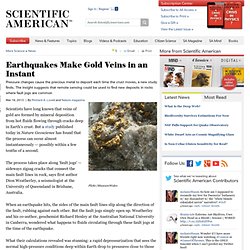
But a study published today in Nature Geoscience has found that the process can occur almost instantaneously — possibly within a few tenths of a second. The process takes place along 'fault jogs' — sideways zigzag cracks that connect the main fault lines in rock, says first author Dion Weatherley, a seismologist at the University of Queensland in Brisbane, Australia. When an earthquake hits, the sides of the main fault lines slip along the direction of the fault, rubbing against each other. But the fault jogs simply open up. Weatherley and his co-author, geochemist Richard Henley at the Australian National University in Canberra, wondered what happens to fluids circulating through these fault jogs at the time of the earthquake. Earthquakes Deposit Gold in Fault Zones. Gold Forms During Earthquakes. Earthquake Turns Water To Gold, Scientists Say. An earthquake can turn water to gold in a matter of seconds, scientists have discovered.

The new study was recently published in the March 17 edition of the journal Nature Geoscience. According to the model presented by researchers, water inside faults jogs vaporizes whenever an earthquake occurs. Earthquakes make gold veins in an instant. Shutterstock.

Dr Dion Weatherley - ESSCC at The University of Queensland. Earthquakes turn water into gold. Heritage Auctions.
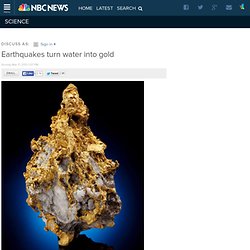
San Andreas Fault, San Andreas Earthquakes, San Andreas Earthquake Risk. Mysterious variations in earthquake activity along the San Andreas fault may be due to saltwater seeping into the rock there, scientists find.
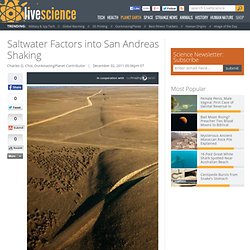
Seismic activity varies significantly along a 30-mile (50-kilometer) stretch of the San Andreas. Motion along this zone from Parkfield, Calif., to Cholame, Calif., can result in earthquakes in some segments of the fault, but other portions stay relatively steady. Researchers had suspected these differences might be due to liquid seeping into rock at some places and weakening it, enabling faults to slip. To learn more, investigators scanned for signs of underground fluid by looking at variations in electrical conductivity along the San Andreas.
Water is typically more electrically conductive than rock, with saltwater far more conductive than freshwater. Hot New Study: Gold Forms Fast. A giant gold deposit could form in an eyeblink of geologic time, scientists announced today.

The large Ladolam deposit on Lihir Island in Papua New Guinea formed inside a recently extinct volcano and was ferried to the surface in solution by rising hot water. By measuring the rate of gold that rises to the surface each year, the researchers estimate that the deposit could have formed in just 55,000 years. Our planet, by comparison, is about 4.5 billion years old. New Zealand's South Island Due for Earthquake. New Zealand has a 30 percent chance of being struck by a major earthquake in the next 50 years, researchers say after developing a new, millennia-long history of earthquakes in the region.
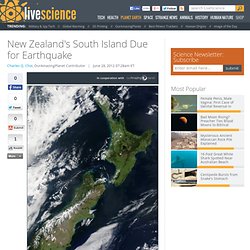
For more than a century, scientists have suspected that major earthquakes recur relatively regularly at major faults, such as where tectonic plates meet. However, long records of earthquakes along such faults are rare, making this idea hard to prove. Now scientists have developed an 8,000-year history of major earthquakes at a site along the Alpine fault in New Zealand, that country's version of California's San Andreas fault. "Really big earthquakes that occur quite infrequently can be tracked over many thousands of years by using high-resolution geological studies," said researcher Kelvin Berryman, a geologist at GNS Science in Lower Hutt, New Zealand.
"The repeat time for these events, at least on some faults, is quite regular. " Layered quake record What's the risk? Earthquakes Turn Water Into Gold, New Study Reveals Magical Natural Phenomenon : Nature & Environment. First Posted: Mar 17, 2013 09:07 PM EDT You've probably heard about ancient alchemists trying to turn lead into gold, but have you heard about scientists turning cement into metal?
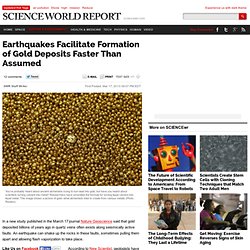
Researchers have unraveled the formula for turning liquid cement into liquid metal. This image shows a picture of gold--what alchemists tried to create from various metals (Photo : Reuters) Gold seams form in an earthquake-powered flash - environment - 17 March 2013. Over 80 per cent of the world's commercial gold deposits formed in a flash.
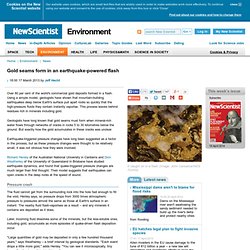
Using a simple model, geologists have shown that mountain-building earthquakes deep below Earth's surface pull apart rocks so quickly that the high-pressure fluids they contain instantly vaporise. This process leaves behind residues rich in minerals including gold. Geologists have long known that gold seams must form when mineral-rich water flows through networks of cracks in rocks 5 to 30 kilometres below the ground. But exactly how the gold accumulates in these cracks was unclear. Earthquake-triggered pressure changes have long been suggested as a factor in the process, but as these pressure changes were thought to be relatively small, it was not obvious how they were involved.
Pressure crash.